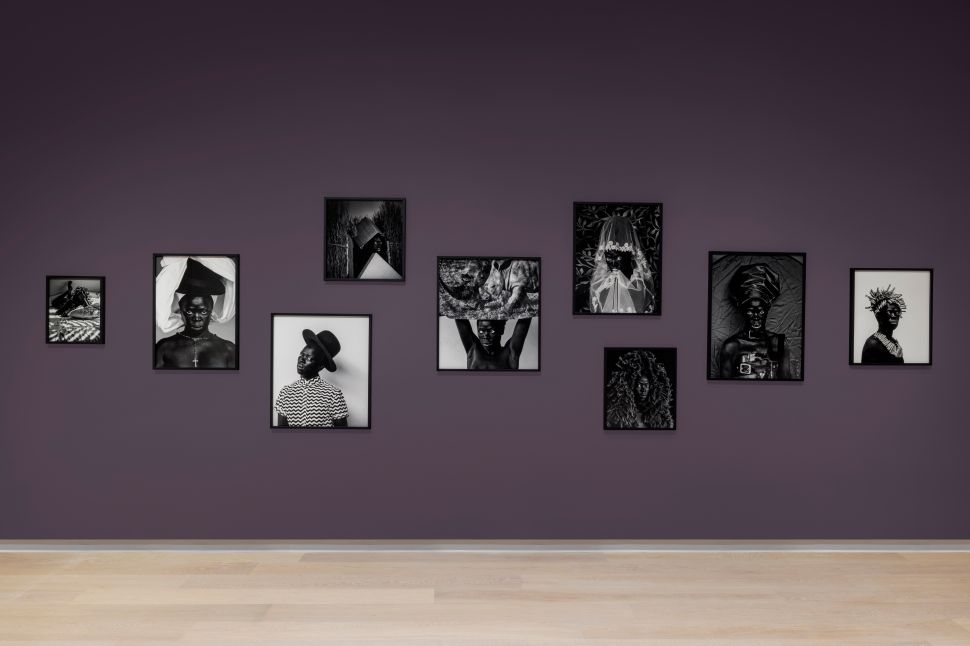An image of a person with a yoga mat draped over their head sounds like a humorous way to begin an exhibition, but in Zanele Muholi’s self-titled solo show at Savannah’s SCAD Museum of Art, it is anything but. Photographed in profile and set on a plum wall, the figure in Fika I, Highpoint I, London (2024)—the artist themself—faces left, their emotionless face framed by a yoga mat which tents over their head and rolls down around their shoulders, covering everything but the artist’s visage. Rendered in high-contrast black-and-white, the artist’s dark skin becomes defined only by its highlights, and the square padding of the yoga mat becomes reptilian scales. The high contrast, lack of color and emphasis on texture remove whatever slapstick humor may have arisen from the composition while at the same time defining a central theme of the exhibition—resistance takes place in the everyday.
The use of familiar things is not devoid of all humor, though. On the wall to the right of Fika I, Highpoint I, London lies another self-portrait, Xiniwe at Cassilhaus, North Carolina (2016). Rendered in the same black-and-white palette against the plum wall, the artist stares directly at the viewer with an expressionless gaze. Their head is covered with a furred turban adorned by an art-deco-inspired jewel. Stacked underneath their chin are two plush cheetah-print rings that, upon closer examination, reveal themselves to be travel neck pillows. What first read as some sort of traditional South African apparel now becomes an unexpected use of a common object.
It is in this subversion of initial readings that Muholi’s humor lies. Playing on their identity as a Black person, Muholi mentally trips up the viewer. Was it only Muholi’s identity that originally gave these objects undue authenticity? What does it say about my white guilt that I would read Muholi’s portrait in this way so easily?
SEE ALSO: “Resistance” at Turner Contemporary Spotlights the Faces of Dissent
The exhibition continues with more selected self-portraits. Taken in toto, this exhibition feels like a mini-retrospective of Muholi’s work—a reading that initially turned me away from the show. Does a living artist with two decades of experience really need a retrospective, despite how illustrious or prolific those twenty years have been? The assumption being that there simply wouldn’t be enough to explore in a relatively short and continually developing career. But the reasoning for this curatorial decision became clear in the next room.
The only gallery with white walls, a not-so-subtle nod to the way whiteness bestows importance on artworks, the final room of the exhibition contains a closely hung array of artworks from two series—Faces and Phases and Brave Beauties—both of which document South Africa’s LGBTQ community. In Kgomotso Mashapa, Parktown, Johannesburg (2014), a light-skinned woman sits in front of a black ground, wearing naught but underwear and stiletto heels. Perhaps she is a sex worker, but this image contains no eroticism. She gazes out at us with ambivalence, her legs askew, her hands resting upon them. For her, this is another day, exceptional only for the photograph of her being taken. And yet, this portrait is defiant. In a country where LGBTQ rights are diminished and the presence of said individuals is persecuted, visibility is resistance. And not just visibility, but incessant visibility. The room, though relatively small, contains two dozen portraits. Such is the power of this room and Muholi’s career—an unending and relentless insistence on the presence and humanity of trans and queer people. It is not always through grand acts that resistance is found but in the occupying of the everyday.
At the zenith of this procession of portraits stands Umkhuseli (The Protector) (2023). A life-size rendering of the artist in resin, marble dust and bronze, the artist is cloaked in floor-length robes and posed with their head bowed and hands meeting, a replication of traditional Christian depictions of saints. Although potentially a self-aggrandizing depiction of the artist, the faux piety of the sculpture indicates the transcendence and protection offered through collective action. Many people are represented in this room but all of them are unified under a common cause. Here, they are enduringly visible. Here, they are persistently resistant. Here, they are unified. Here, they are safe.
“Zanele Muholi” is at the SCAD Museum of Art through July 7, 2025.

